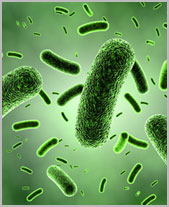
Toxic Bowel Syndrome (TBS) Breath Test

When an individual is exposed to mold infested environments, their exposure is to more than just mold. Commonly present are mycotoxins, endotoxins, yeast, parasites, environmental bacteria and other toxic substances.
Toxic Bowel Syndrome or TBS testing can detect inflammation or indicators which are caused from these exposures. TBS is a condition in which abnormally large numbers of bacteria and other toxic substances the types that are normally found in the large intestine are present in the small intestine.
When not functioning properly, the migrating motor complex (MMC) fails to effectively sweep intestinal contents into the colon during periods of fasting. As a result, the invasive bacteria and other environmental toxins interfere with healthy digestive and absorption processed, leading to unpleasant symptoms and chronic illness.
The main symptoms of Toxic Bowel Syndrome (TBS) are those of Irritable Bowel Syndrome (IBS). TBS has been shown to exist in up to 84% of IBS patients and is therefore theorized to be the underlying cause. It is associated with many other disorders as well, as an underlying cause or as an aftereffect of the pre-existing disease.

Some of the causes of Toxic Bowel Syndrome:
- Exposure to mold
- Exposure to yeast
- Exposure to environmental bacteria
- Exposure to mycotoxins
- Exposure to endotoxins
- Exposure to exotoxins
- Exposure to enterotoxins
- Overgrowth of Candida (Yeast)
- Presence of H. pylori
- Parasitic infections
Symptoms of Toxic Bowel Syndrome:
TBS IBS Symptoms
Abdominal bloating (gas) – belching, flatulence
Abdominal pain, cramps
Constipation, Diarrhea, both
Other TBS symptoms
Heartburn (Reflux or GERD)
Nausea
Leaky Gut Symptoms (I prefer to call this Leaky Small Intestine)
Food Sensitivities
Headaches
Joint Pain
Fatigue
Skin symptoms (such as eczema or rashes)
Respiratory symptoms (such as asthma)
Mood symptoms (such as depression)
Brain symptoms (such as Autism)
TBS Malabsorption Symptoms
Steatorrhea (fatty stools)
Anemia (Iron or B12)
Weight Loss
Associated Conditions- see SIBO Diseases for Study links
Acne Roseacea
Acromegaly
Age: Elderly
Alcohol Consumption (moderate intake)
Anemia
Atrophic Gastritis
Autism
Celiac Disease
Chronic Fatigue Syndrome
CLL (Chronic Lymphocytic Leukemia)
Cystic Fibrosis
Diabetes
Diverticulitis
Dyspepsia
Erosive Esophagitis
Fibromyalgia
Gallstones
Gastroparesis
GERD (Gastroesophageal Reflux Disease)
Hepatic Encephalopathy (Minimal)
Hepatic Steatosis
H pylori Infection
Hyprochlorhydria
Hypothyroid/ Hashimoto’s Thyroiditis
IBD (Inflammatory Bowel Disease)
-Crohn’s
-Ulcerative Colitis
IBS (Irritable Bowel Syndrome)
Interstitial Cystitis
Lactose Intolerance
Leaky Gut
Liver cirrhosis
Lyme
Medications: Proton Pump Inhibitors, Opiates, NSAIDS Myelomeningocele
Muscular Dystrophy (myotonic Type 1)
NASH/NAFLD (non-alcoholic: steatohepatitis/fatty liver disease)
Obesity
Pancreatitis
Parasites
Parkinson’s
Prostatitis (chronic)
Radiation Enteropathy
Restless Leg Syndrome
Rheumatoid Arthritis
Scleroderma
Surgery: Post-Gastrectomy
In particular, if the symptoms of IBS are present, or one of the associated diseases along with digestive symptoms is present, consider TBS.
How Is the Test Performed?
- There is a 24-hour preparation phase before the test is performed.
- In the first 12 hours, dietary restrictions must be followed. The patient must avoid all grains, fruit
in all its forms, sugar in all its forms, dairy in all its forms, vegetables, nuts and seeds, alcohol and
beans. Refer to the test kit instructions for permitted foods. - The last 12 hours is a fasting period. Only water can be consumed.
- Included in the test kit is a packet of lactulose that is to be mixed with 4 ounces of water
then set aside. - Collect a baseline breath sample before consuming the lactulose mixture.
- After collecting the baseline breath sample, drink the lactulose mixture.
- Twenty minutes after consuming the lactulose mixture, breath sample #2 is collected. Breath
samples are collected every 20 minutes thereafter until all tubes are used. - Please refer to test kit instructions for more specifics on how to perform the collections
and detailed instructions on medications, circumstances, underlying medical conditions,
supplements, diet, etc. that may affect the results of the test.
Refer to test kit instructions for more specifics on how to do the collections and detailed instructions on
medications, circumstances, underlying medical conditions, supplements, diet, etc. that may affect the
results of the test.


